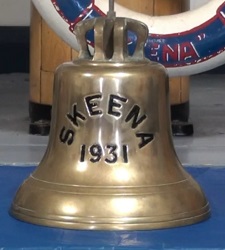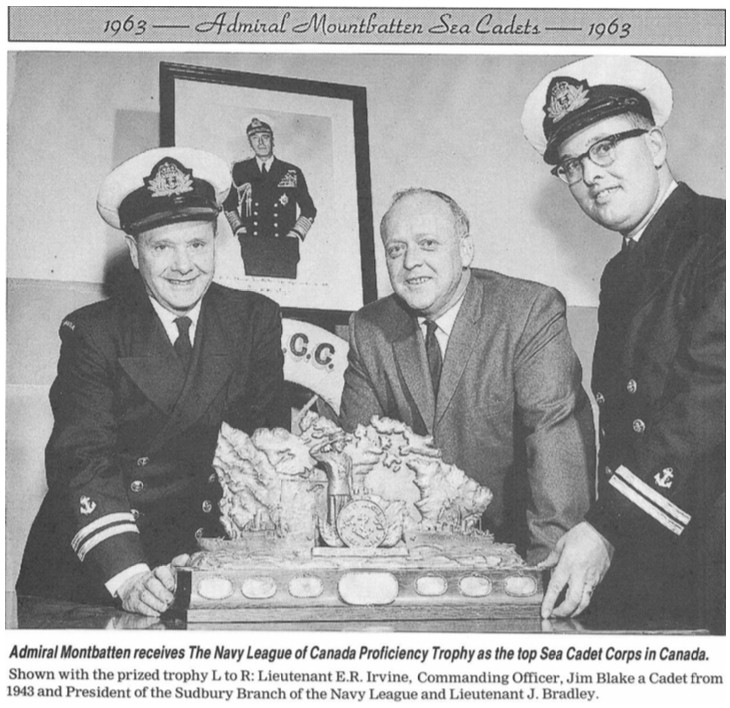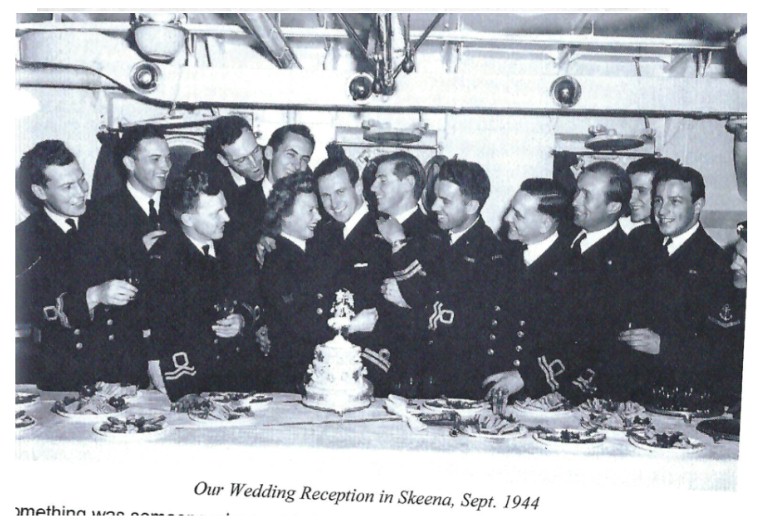|
The Ship's Bell for
HMCS SKEENA H01 / D59 / I59
The bell for HMCS SKEENA is located at RCSCC SKEENA, Port Hope, Ontario Photos Credit: Today's Northumberland, 26 Oct 2020
The story behind the bell: When L/SA Willard Stewart (Bill) MacRae returned to Canada after surviving the grounding and wreck of HMCS SKEENA, he brought with him the ship's bell that he entrusted to his sister Marjorie to keep the safe for him. Bill had the bell re-finished and decided not to return it to the navy when former crew members were told they could, but were not required to, return items from the original SKEENA for placement on the SKEENA 207. Having chosen not to return the bell he left it in his sister’s care up until he gave the bell to the Burlington Naval Club before his passing. After his death, Bill's sister and her family attended the bell when it was taken down to the Burlington waterfront for ceremonies.
After the Burlington Naval Club disbanded, the bell for SKEENA ended up on HMCS HAIDA, the RCN naval museum ship in Hamilton, ON and the last surviving ship of the Canadian wartime Tribal class destroyers. When Parks Canada took over ownership of HMCS HAIDA, the bell at some point vanished, and years of searching by LT (N) Chris Barker of RCSCC SKEENA, found the bell at the CF Staff College in Toronto. After a few years of communication the bell was finally re-located to RCSCC SKEENA where it is now proudly displayed.
RCSCC Admiral Mountbatten’s Connection to the HMCS Skeena when she met her unworthy end by Dan Desgrosseilliers
I recently had the opportunity to bring five pieces of a puzzle involving three gentlemen with connections with our corps and the HMCS Skeena. Before I introduce these gentlemen, I first would like to introduce the ship. James Brun, in his excellent article available at the following link - https://militaryhistorynow.com -describes her as follows: “His Majesty's Canadian Ship Skeena was a River-class destroyer and one of the first two ships built expressly for the Royal Canadian Navy (RCN). She served as an escort on the deadly North Atlantic run during the Second World War, destroyed a German U-boat, guarded the D-Day invasion force from enemy submarines, and sunk surface raiders off the coast of France. Despite her illustrious wartime record, she met an ignoble end: smashed upon Iceland’s frigid shores amidst a terrible gale. Her story is emblematic of the wider Atlantic campaign – bitter, grinding, and occasionally, unforgivingly violent.” The ship came to an abrupt end on 24-25 October 1944, coming up on 78 years ago.
Well it turns out the following three gentlemen were members of the ship’s company that fateful night. E.R. Irvine a Wireless Operator/Communicator; William Kidd, Skeena’s First Lieutenant; and Peter Chance her Navigator. You may be asking, how is our corps connected with these three men and the Skeena. Well let me tell you.
The first one will be obvious to some of our more senior Alumni and some of you may know E.R. Irvine as Lt E.R. Irvine, 7th Commanding Officer (1962-1966) of RCSCC Admiral Mountbatten. Under Lt Irvine’s command, the corps was awarded the Navy League of Canada Proficiency Trophy in 1963, for the first of many occasions. Thistrophy was awarded to the best Sea Cadet Corps in Canada. On his retirement, he presented the Corps with HMCS Skeena’s Ensign which wasstruck as she was sinking (note: this Ensign is now in possession of the Naval Museum of Halifax).
Capt (N) William Kidd was introduced to RCSCC Admiral Mountbatten when he accepted an invitation to be a guest speaker at the annual Navy Night ’82, a naval themed mess dinner hosted by the Irish Regiment Officers’ Mess and organized by me. I was looking through the listing of members of the Naval Officers Association for a possible guest speaker and came across Capt (N) William Kidd, who was at the time living in Elliott Lake ON. Capt (N) Kidd was contacted and he graciously accepted the invitation. Following the dinner and his outstanding talk, he was approached by Cdr Bradley to discuss the possibility of starting up a Navy League Branch and Navy League Cadet Corps in Elliot Lake. Within a few years a Navy League Branch and corps was formed and in 1986 an Elliot Lake Satellite Division of Sea Cadets was formed, reporting to RCSCC Admiral Mountbatten. The Division was then established as RCSCC Captain Kidd (# 306) in 1988. Captain Kidd was invited to be the Reviewing Officer at the first Annual Review of hisn amesake. Regrettably he crossed the bar before the Annual Review.
Cdr Bradley, and Lt(N) John Moland (who would become CO’s of RCSCC Admiral Mountbatten), were witness as young cadets to the 1946 presentation, by our third gentleman Lt Peter Chance, of the HMCS Sudbury and HMCS Copper Cliff Bells to the respective city mayors,.Another interesting fact was that Lt Kidd was Lt Chance’s best man at his wedding in September, 1944, weeks before the loss of their ship. While Cdr Bradley was in Halifax to celebrate the RCN’s Centennial in 2010, he again had an opportunity to meet Cdr Chance aboard HMCS Sackville. Cdr Chance remembered very well his role in returning the Ship’s Bells and found it very amusing to meet someone who was there. Cdr Bradley also shared the story that he presented the same bell to the Mayor of Sudbury in 1983, which is now permanently installed in a showcase at City Hall with the RCSCC Admiral Mountbatten original bell and other corps memorabilia. Cdr Chance will soon be 102 years old and is living in Sidney BC and still very active with the Naval Community across the country.
Centre - Lt William Kidd with hand on Groom's (Lt Peter Chance) shoulder.
Click here for more information on HMCS SKEENA H01 / D59 / I59
This page was last updated on 23 Jun 2025
|




